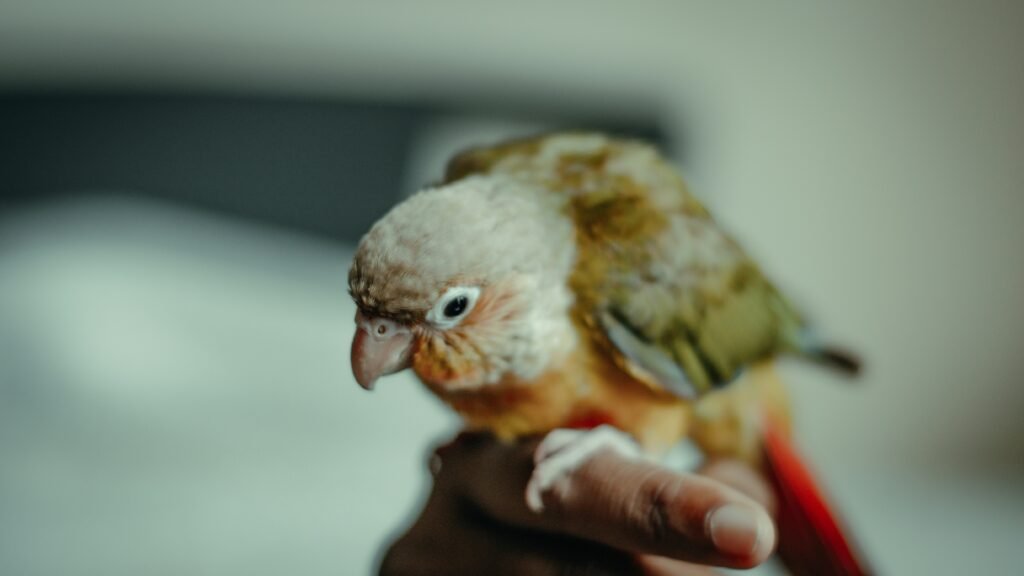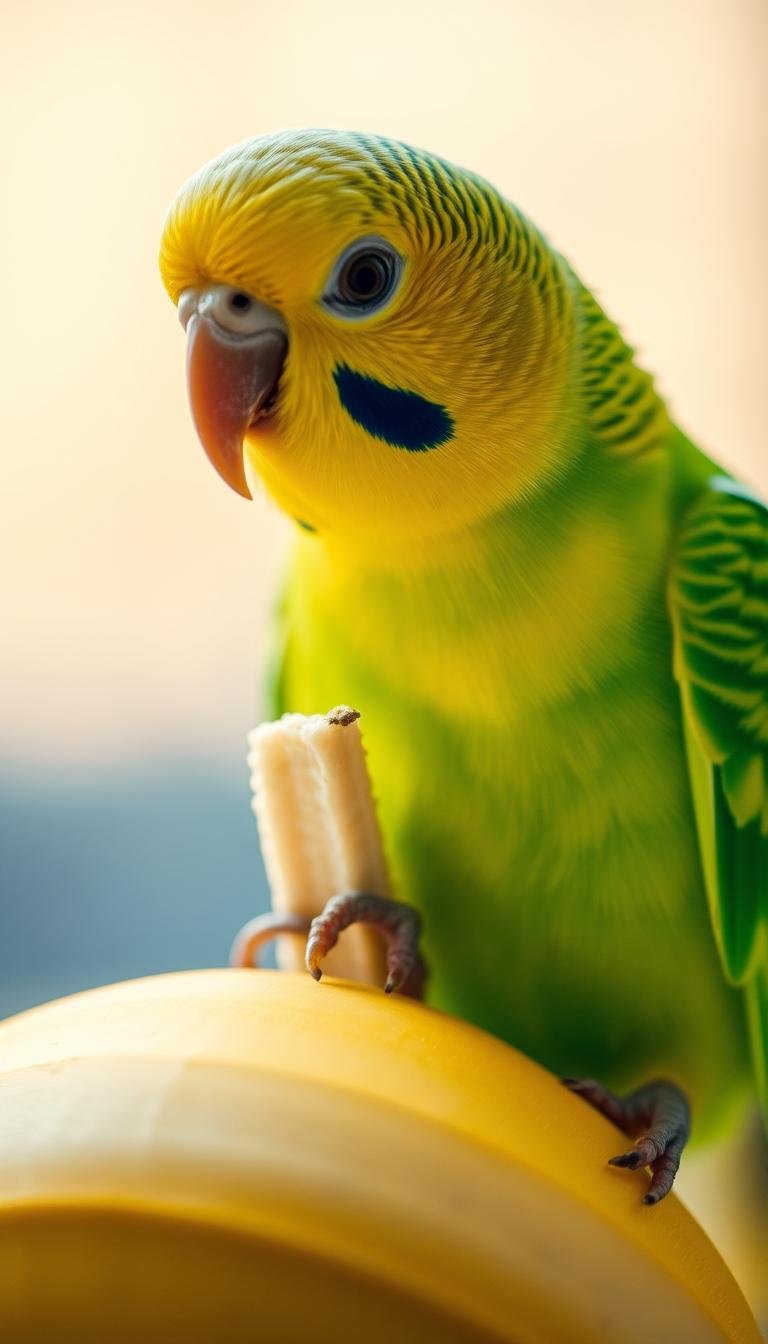Pineapple conures are a special color variation of green cheek conures. They were bred by Steve Garvin to mix opaline and cinnamon traits. These small birds are 9–10 inches long and weigh 60–80 grams. They have bright yellow-orange chests, tan heads, and lime green backs.
They are friendly, quiet, and easy to care for. This makes them perfect for living in apartments.
These birds need daily interaction and a balanced diet of pellets, fruits, and veggies. With the right care, they can live up to 30 years. Unlike loud parrots, they are calm. For more information, check out this article.
- Bred through selective breeding for striking color patterns
- Manageable size (9-10″) and low noise level
- Require daily mental stimulation and social interaction
- Can live 30+ years with proper care
- Adaptable to apartment living due to quiet nature
What Makes the Pineapple Conure Special
Pineapple Conures are loved by bird lovers for their bright looks and fun pineapple conure characteristics. They have tan heads, lime green backs, and cinnamon spots. This look comes from special breeding by Steve Garvin. Unlike their wild cousins, these birds do well in homes that feel like their natural habitat
Origin and Natural Habitat
These birds were made in captivity by mixing different traits. While their wild relatives live in forests, Pineapple Conures need us to create fun spaces. A good has perches, toys, and room to fly, matching their lively nature.
Popularity as Companion Birds
- People love their for being loving and fun, always wanting to play.
- They are quieter than other conures, making them great for apartments.
- They can learn tricks and even say simple words, making them even more special.
Their shows they love to explore and play, like nuzzling and backflips.
Lifespan and Health Considerations
With the right care, these birds can live over 25 years. A good diet, vet visits, and fun activities help them stay healthy and avoid problems like feather plucking. Not giving them enough attention can make them aggressive. It’s important to keep them active and happy, like their wild relatives as seen in related species.
Knowing how they act helps us have a good relationship with them. Their long life means we must take care of them fully.
Physical Characteristics and Colors
Pineapple conures are easy to spot because of their bright pineapple conure colors. They have a tan head and lime green back feathers. Their sides are bright yellow, and their chest is a red-orange color, making them look like a pineapple. They are about 10 inches long and weigh 2–3 ounces, making them small but colorful birds.

They have a special mix of cinnamon and yellow-sided feathers. Their head is tan, and their wings are lime green. Their belly is bright red and yellow. Some have orange wing patches, which is rare. Their ruby-red eyes and pale rings around them make them look even more exotic.
Key pineapple conure characteristics include:
- Tail feathers with a “halo effect” similar to yellow-sided conures
- Average lifespan of up to 25 years with proper care
- Compact size (9–10 inches) ideal for small living spaces
It’s hard to tell if a pineapple conure is male or female just by looking. Most people use DNA testing because males and females have the same pineapple conure colors. They are light (60–80 grams) and full of energy, showing their playful side. Their bold colors and small size make them a great pet choice.
Caring for Your Pineapple Conure
Proper care is key for your lively pineapple conure to thrive. They can live up to 20 years. Their diet should include 65-70% high-quality pellets, fresh fruits, and veggies. Avoid giving them avocado, chocolate, or salty snacks as they can be harmful. Use stainless steel or ceramic bowls for meals to stop bacterial growth. Similar species need similar diets, but adjust portions based on your bird’s size.
Cage Setup Essentials: A 24”x24”x30” cage is a good start for space. For more active birds, a 36”x24”x24” cage is better. Use natural wood perches and add UVB lighting for foot health and calcium absorption. Clean the cage weekly with safe bedding materials.
| Key Diet Components | Recommended Percentage |
|---|---|
| Pellets | 65-70% |
| Fruits | 20-30% |
| Vegetables | 10-15% |
| Seeds | Limit to occasional treats |
Enrichment is crucial to prevent behavior issues like feather plucking. Give them rope toys, ladders, and puzzle feeders. Change toys weekly to keep them interested. Spend 2-4 hours with them outside of their cage daily for exercise. Watch for signs of illness like fluffed feathers or lethargy, and see a vet right away.
- Use non-toxic plastic toys; avoid rope toys that fray.
- Trim nails and wings regularly during grooming sessions.
- Keep cages away from drafts and direct sunlight for optimal health.
Take your pineapple conure for an annual vet checkup with an avian specialist. Quarantine new birds to prevent disease spread. Meeting these needs ensures your pineapple conure lives a happy, healthy life.
Getting to Know the Pineapple Conure: Behavior and Personality Traits
Pineapple conures are full of curiosity and love to be around people. They form strong bonds with their owners. Their pineapple conure personality is a mix of fun and loving, making them great friends. They love to climb, play, and even learn tricks with treats.
- Playful: They enjoy playing with toys and checking out new places.
- Social: They need people around them all the time and can get upset if they don’t get enough attention.
- Quiet: They make softer sounds than bigger parrots, but can get loud when they’re excited.
- Intelligent: They are smart and can figure out puzzles and learn tricks.
Pineapple conures are full of energy but also know how to relax. They love to cuddle and be close to people. They can live in apartments if they get enough attention. It’s important to give them fun toys and spend time with them to keep them happy.
Getting them used to people early on helps them feel confident and less shy. They love to play and can do silly things like hang upside-down to get attention. Having a special play area and regular time with them keeps them happy and well-adjusted.
Conclusion: Is a Pineapple Conure Right for You?
Pineapple Conures are known for their bright colors and fun personalities. But, owning one is a big decision. They are small, about 10 inches long, and fit well in apartments. However, they need daily interaction to stay happy and healthy.
It’s important to feed them a mix of pellets, fruits, and veggies. The wrong diet can cause health problems like obesity.
These birds need a big cage with lots of toys and perches. This keeps them active and happy. They can live up to 20–30 years, which means a big commitment. The initial cost is $200–$500, and there are ongoing expenses too.
Some people might find their noise too much. But, they are generally quieter than bigger parrots.
Thinking about getting a Pineapple Conure? You need to make sure you can give them the time and space they need. They require a lot of attention and a safe, fun place to live. If you can do this, they can be wonderful pets.



0 Comments